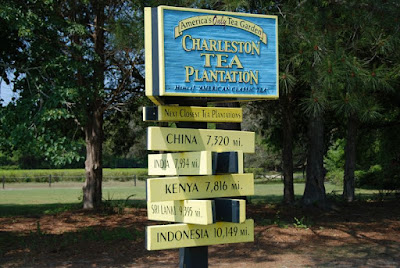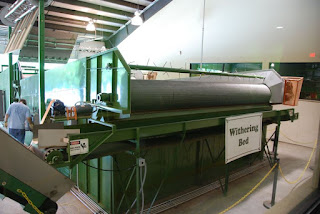Today we took a break from the ordinary and ventured a few miles outside of Charleston to visit America’s only Tea Garden ( www.charlestonteaplantation.com ). It is from here that American Classic Teas are grown and made. There are currently 127 acres filled with tea plants. From 1963 until 1987, the plantation was a research site for the Lipton Company (out of England). They were experimenting and trying to find how and what types of tea could be grown in America. In 1987, the property was purchased by a master tea taster and the American Classic teas were developed. In 2003, the Plantation was purchased by the Bigelow family who were tea producers in their own right. Just recently, the Tea Plantation has a contract with a major national grocery store and will eventually be on shelves across the country. They will start small, only in the southeast at first, then, as production increases, will expand throughout the nation. They offer a trolley tour of the grounds where you can see the production in action. Right now, the tea bushes are waking from a winter dormancy and should be ready for the first cutting harvest around the first of May. Then they will be cut weekly through the summer and into late October.
The new growth leaves are the only thing that they harvest and use. The top 3-4 inches are cut using a one-of-a-kind machine they nicknamed the “Green Giant”. It was designed and built on the property using parts from tractors and tobacco cultivators.
There is a set of cutting blades, that look similar to a big set of electric hedge clippers in the lower center of the vehicle. Large blowers are mounted forwards of the blades and blow the cuttings up the chute and into the collection basket at the end.
When full, this basket is dumped into a pickup truck and hauled to the factory (on property). In the rest of the world, tea is harvested by hand, much as it has for centuries. This machine does the work of 500 field hands! In fact, the Plantation has only 4 employees that manage and harvest the tea. They have a couple of trolley drivers and four ladies in the gift shop/reception center. After harvest, the tea leaves are brought in to what is called the Withering bed.
The leaves are spread out and large blowers circulate air around the leaves in order to dry them out.
They next follow up a conveyor belt where they are fed into a series of grinders and the tea leaves are turned into a mulch like product. This breaks up the plant cells and allows chemical processes to occur which affects the flavor of the tea. This product is then spread onto another conveyor belt and run into the dryer. The type of tea desired determines how long it stays in the dryer. Black tea stays for 50 minutes. Oolong tea stays for only 15 minutes. Green tea skips this drying step altogether.
The dried tea is then sifted twice to remove any bits of stem and debris. The end result is the tea that is ready for sale. Loose tea is canned and ready for sale or shipment on premise. Tea for tea bags is sent to the Bigelow processing facility in the Northeast for packaging and sale.
After the tours, you are welcome to stroll around the grounds or visit the gift shop, where you can sample both hot and cold teas to your hearts content (bathrooms are conveniently located just outside).
On the way back to the motorhome, we stopped by Angel Oak Park. Here is a 300-400 year old Live Oak tree. This monster is as wide as it is tall and is easily as big as a two story home. The branches spread out and touch the ground in many cases. You can see the size of the trunk in comparison to me. You see the Live Oak trees all over the southern coastal areas. The wood is very strong and was a prized component for many wooden ocean going ships. The USS Constitution (Old Ironsides) was made from Live Oak. The canopy created by these trees makes all of the beautiful lanes that you think of when you think of the old South. Point of trivia, the Live Oak gets its name from the fact that it always has green leaves in abundance. While other oak trees go dormant and loose their leaves, the live oak always has green leaves.
Back early to the campground today and we are packing up in order to head further northwards tomorrow.











No comments:
Post a Comment